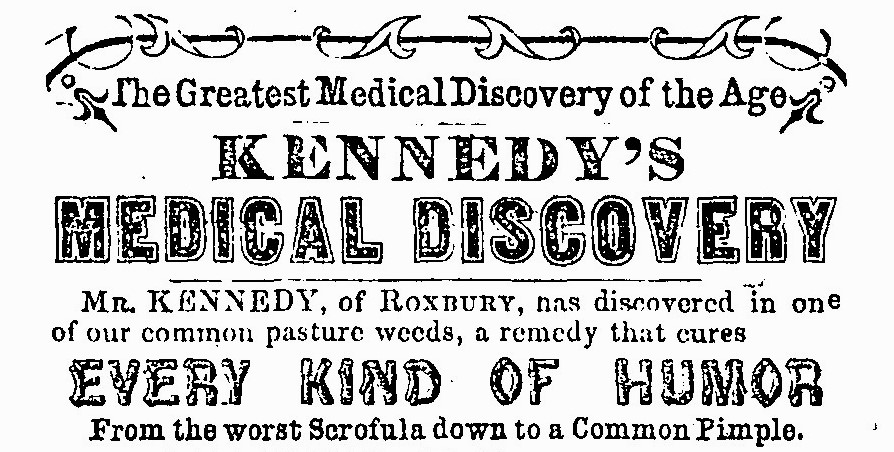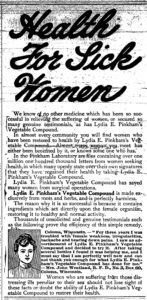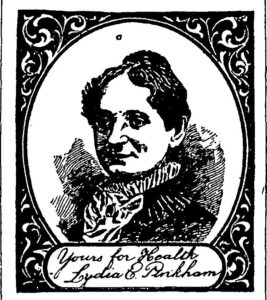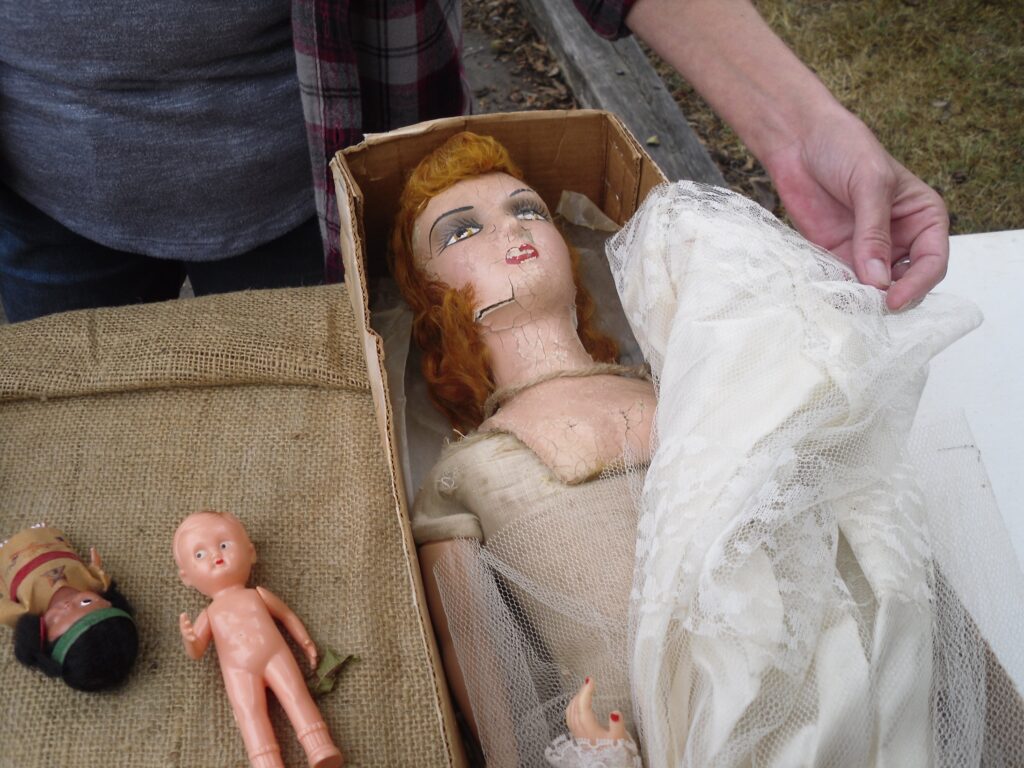
Patent Medicines in Westborough
When I was young, I became interested in patent medicines and medicine shows from the nineteenth and early twentieth centuries for a variety of reasons—one of which was finding in my local library the book, Medicine Show: Conning People and Making them Like It by Mary Calhoun. Soon after reading it, I discovered a carton holding old medicine bottles for sale in the back corner of an antique shop while on a family vacation, so of course I had to start collecting them.
Along with their odd shapes, the main appeal of these bottles is the exotic names of the medicines that are embossed on the glass: Hamlin’s Wizard Oil, Dr. John Bull’s Worm Destroyer, Ka-Ton-Ka Tonic, Hinkley’s Bone Liniment, and Kr. Kilmer’s Swamp Root Kidney Liver & Bladder Cure, to name a few. How can anyone resist such magical elixirs, even if most of the bottles are now empty?!

Medicine shows were widespread and influential in the latter decades of the nineteenth century. The two biggest companies—Hamlin’s Wizard Oil Company based in Chicago and the Kickapoo Indian Medicine Company in New Haven, CT—sent traveling shows in horse-drawn wagons to small towns across the United States both to entertain the people with music, dancing, and vaudeville skits and, of course, to sell medicine. Smaller companies and even independent solo acts crisscrossed the country as well.
Entertainment in isolated rural areas was hard to come by, so when a medicine show came to town, it was a big deal. After the entertainers warmed up the crowd, the doctor made his dramatic appearance to pitch his wonder drug, demonstrate its efficacy, and sell it for the low price of $1.00 per bottle. With limited medical care available in these parts of the U.S., the promise of easy solutions to what generally amounted to common medical ailments was an easy sell. People eagerly bought up these miracle medicines, which could supposedly protect us from disease or make symptoms quickly go away.

In truth, most of these so-called medicines were a mixture of rain water, herbs, Epsom salts, and/or coloring, but the most important ingredient was usually alcohol to give the medicine a kick. Sometimes, the medicine would be created behind the scenes in a washtub before the show, especially if the traveling show was a small and independent one. Many of these medicines functioned simply as laxatives, which was enough to make stomach issues, which afflicted most people given their diet at the time, go away.
In addition to sponsoring traveling medicine shows, a lot of patent medicine companies advertised heavily in newspapers, especially those covering small, rural towns. Patent medicines were big business starting in the middle of the nineteenth century, so it’s not surprising that the pages of The Westborough Chronotype are full of advertisements and testimonials that tout the effectiveness of these medicines in combating disease.

The early years of The Westborough Chronotype contain hosts of ads for Ayer’s, Dana’s, and Hood’s Sarsaparillas (a kind of tonic), Dr. Kennedy’s Medical Discovery, Kickapoo Indian Sagwa and Oil, and Lydia E. Pinkham’s Vegetable Compound. The latter was aimed specifically at women to cure “female complaints” and was perhaps the best-selling patent medicine of all time. The fact that it was mainly made up of alcohol—and so provided a discreet and socially acceptable means for housewives to consume it and continue to claim temperance—certainly contributed to its success.

In 1951, Fred Taylor wrote an article in the Westborough Chronicle recalling life in Westborough before 1900. In his list of entertainments, he mentions that “A tribe of Kickapoo Indians hired the old town hall for a week and put on many of their tribal dances and also sold their ‘Sagwa’ and other medicines.” Indeed, after touring Northborough and Shrewsbury, the Kickapoo Indian company performed at the Westborough Town Hall for two weeks starting on April 3, 1894. The Chronicle reported during the run, “The Kickapoo Indian Medicine company have had crowded houses this week. The doctor in charge is a good speaker and seems to know what he is talking about.” Kickapoo Indian Remedies were also available year-round in local drug stores, such as the Westboro Pharmacy and pharmacists Arthur E. Longley & Co on the Post Office block.

While some of the larger companies maintained good reputations—even if the efficacy of their medicines was questionable at best—less scrupulous imitators who failed to entertain the crowd, barely hid the con they were practicing, and produced medicines that contained dangerous narcotics and actually made people sick brought more and more attention to the perpetrated fraud. Newspaper and magazine articles began to spread information about the dangers of quack medicines, and as a result many towns began to ban traveling medicine shows or charge high licensing fees for them to perform.
In 1907, the Pure Food and Drug Act went into effect to protect consumers and banned the word “cure” from being used in relation to a commercial product (which also makes it easier to date bottles that have this term on their labels). With the advent of movies and automobiles, the entertainment provided by traveling shows also started to go out of fashion. All of these developments made it more difficult for medicine shows to operate. By the mid-1950s, the medicine show was completely dead. But many of the sales techniques and promises of quick and easy relief from medical conditions live on, except now they appear on television, radio, the web, and social media in the guise of herbal supplements, quasi-medical devices, “natural” remedies, and other dubious products.
—Anthony Vaver, Local History Librarian
Works Consulted
- A Collector’s Guide to Patent and Proprietary Medicine Bottles of the Nineteenth Century by Joseph K. Baldwin.
- Medicine Show: Conning People and Making Them Like It by Mary Calhoun.
- Snake Oil, Hustlers, and Hambones: The American Medicine Show by Ann Anderson.
- Step Right Up, Rev. ed., by Brooks McNamara.
- Westborough Chronotype:
- Ad, April 14, 1894, p. 5.
- Ad, April 21, 1894, p. 5
- Notice, March 31, 1894, p. 5.
- Notice, April 7, 1894, p. 5.
- Notice, April 14, 1894, p. 5.
- “Remarkable Growth,” September 02, 1893, p. 2.
- “Westborough before 1900,” November 16, 1951, p. 2.
* * *

Exhibit Celebrating the 250th Anniversary of the 1774 March to Worcester
On September 6, 1774, 250 years ago, Westborough participated in the March to Worcester, which many historians consider the true beginning of the American Revolution (take that, Lexington and Concord!).
Learn about this historic event in an exhibit that is now on display until the end of September on the main floor of the Westborough Public Library. You can also learn more about the March to Worcester by reading the “exhibit catalog” I created for the Militia Training Day event that was held as part of Westborough’s 300th anniversary celebration back in 2017: The Rebellion Begins: Westborough and the Start of the American Revolution, which is available in the library.
* * *

Westborough Historical Society Program on Dolls and Their History
On Monday, October 7 at 7 p.m. at the Sibley House (13 Parkman St.), doll collector Janice McIntyre, who has appeared on Chronicle, will present a program called, “The World of Dolls.”
McIntyre will bring back childhood memories of Barbie and before as she covers the history of dolls over six decades and discusses how dolls were created and how the process has changed over time. She will also be displaying 60 dolls from the 1800s to the 1950s. Feel free to bring in your own antique or exotic dolls to show.
* * *

Nature Notes
Annie Reid has been wanting to write about bobcats for a while. Good thing she waited until now to do so, because she has produced one of her most detailed Nature Notes article yet with the inclusion of video footage of a bobcat here in Westborough! You can read her fascinating article here: https://westboroughlandtrust.org/nn/nn321.
With the cooler temperatures, September is a great time to go out into the woods. Make sure to use Reid’s Nature Notes for September as a guide, so you know what to look for and expect. But don’t let the presence of bobcats deter you: they tend to be active during the hours of dusk, night, and dawn—times when we are unlikely to be in the woods—and they are generally shy and secretive, so you are unlikely to come across one.
* * *
New Resource Guides
Over the years I have been in my position, I have created or kept drafts of Resource Guides to help researchers working on certain topics find items that may otherwise remain hidden away in the Westborough Archives. I have now posted most of these on the Westborough Archive website, even if some of them continue to be “in process.” Take a look, and if you see anything that interests you, stop by the Westborough Center and I will be happy to show it to you.
- Early Vital Records
- Research Your House
- Books about Westborough History
- Online Genealogy Resources
- Westborough State Reform and Lyman School Resources
- Native American Resources in the Westborough Public Library
- Africans and African-Americans in Westborough History (Draft)
- Sources for the Forbes Family and the Forbes High School in the Westborough Public Library
* * *
Did you enjoy reading this Westborough Center Pastimes newsletter? Then subscribe by e-mail and have the newsletter and other notices from the Westborough Center for History and Culture at the Westborough Public Library delivered directly to your e-mail inbox.
You can also read the current and past issues on the Web by clicking here.
Dear The Westborough Center for History and Culture and Dr. Vaver: Because I am a former childhood resident of Westborough and a recipient of the wonderful local historical and local cultural education provided by the WPS system, I read your online publication with great interest. I hope you will be able to keep them coming as the years pass by. People need to be reminded of the richness and often amusingness of the past. Gerry
Thank you, Gerry, for your kind words!